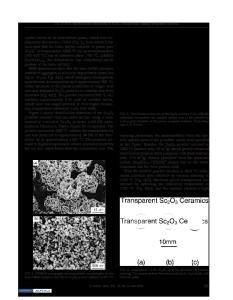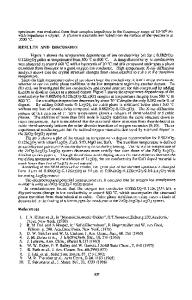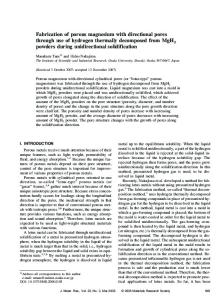Fabrication of transparent Sc 2 O 3 ceramics with powders thermally pyrolyzed from sulfate
- PDF / 404,262 Bytes
- 7 Pages / 612 x 792 pts (letter) Page_size
- 79 Downloads / 326 Views
Scandia (Sc2O3) is a ceramic material that shows interesting thermal and optical properties, but is difficult to grow as single crystals. As an alternative, in this work we fabricated polycrystalline Sc2O3 transparent ceramics via vacuum sintering, using powders thermally pyrolyzed at 1200 °C from a scandium sulfate salt, Sc2(SO4)3 · 7.8H2O, that we prepared. Characterization of the powders was achieved by differential thermal analysis/thermogravimetry, x-ray diffractometry, Brunauer–Emmett–Teller analysis, and field-emission scanning electron microscopy. Sintering behaviors of the Sc2O3 powders were studied in air via dilatometry. The sulfate salt transforms to oxide at temperatures 艌1000 °C, and the best pyrolysis temperature for transparent ceramics fabrication is 1200 °C, at which the resultant Sc2O3 powder is good in dispersion, ultrafine in particle size (∼80 nm), and almost free from residual sulfur. Transparent ceramics were fabricated from this powder via vacuum sintering at 1625 °C or above. The ceramics sintered at 1700 °C for 4 h exhibit an in-line transmittance of approximately 56–58% in the visible light region at a sample thickness of 1.0 mm. I. INTRODUCTION
Scandia (Sc2O3) is a cubic ceramic material (space group, Ia3) that has a high bulk refractive index (nH ⳱ 2.0 at ⳱ 300 nm), a high band gap [5.7 eV, corresponding to an ultraviolet (UV) cut-off of 215 nm], and a high melting point (∼2430 °C).1–3 The reported thermal conductivity for Sc2O3 (17 W/mK) is also higher than those for Y2O3 (14 W/mK) and Y3Al5O12 (YAG; 11 W/mK),4 two important host materials for solid-state lasers. A unique combination of these optical and thermal properties makes Sc2O3 ceramics attractive for applications such as damage-resistant and high-reflection material in light-emitting diodes and high-power pulsed UV lasers, as a host material for high-power laser oscillations, and as infrared and high-temperature windows under stringent environmental conditions. The growth of Sc2O3 single crystals by the Czochralski method proved to be rather difficult. Actually, durable crucibles compatible with the Sc2O3 melt have not been found to date.4 Other techniques have also been investigated for single-crystal growth, including the Verneuil method,5 the flux method,6 the floating zone method,7 and the laser-heated pedestal growth method.8 Unfortunately, the resultant crystals are either limited in size or contaminated with impurities. a)
Address all correspondence to this author. e-mail: [email protected]
1816
http://journals.cambridge.org
J. Mater. Res., Vol. 18, No. 8, Aug 2003 Downloaded: 13 Mar 2015
An alternative to Sc2O3 single crystals is transparent polycrystalline ceramics fabricated via sintering techniques. In contrast to the well-known Al2O3 (hexagonal) translucent ceramics (the Lucalox), Sc2O3 can potentially be sintered to good optical transparency, as its cubic crystal structure precludes any birefringence effects at grain boundaries. Because a nearly pore-free microstructure is required for ceramics to show
Data Loading...











